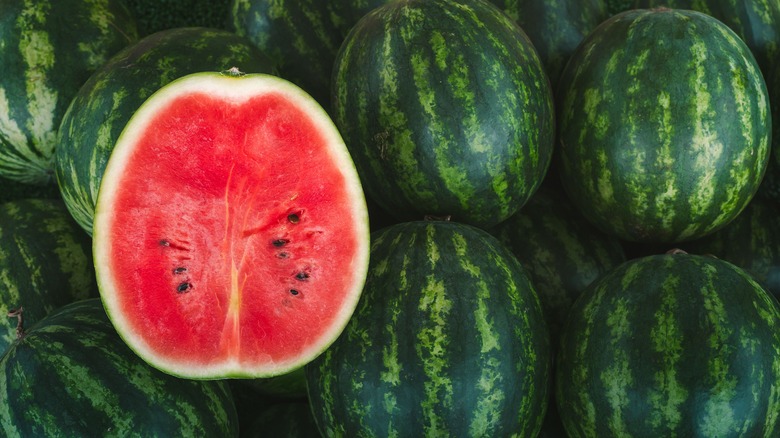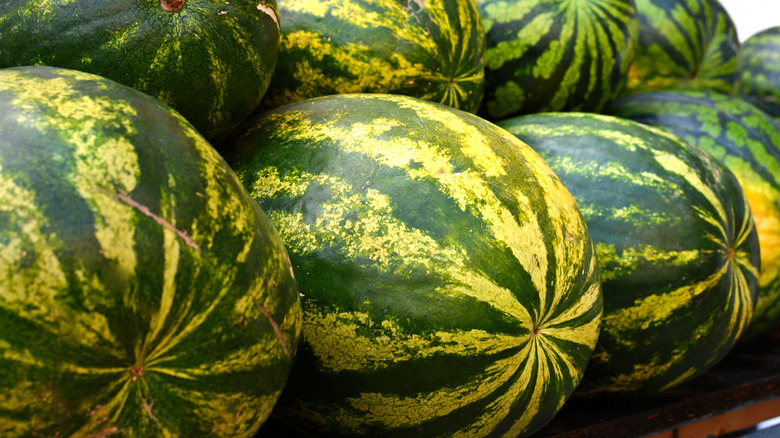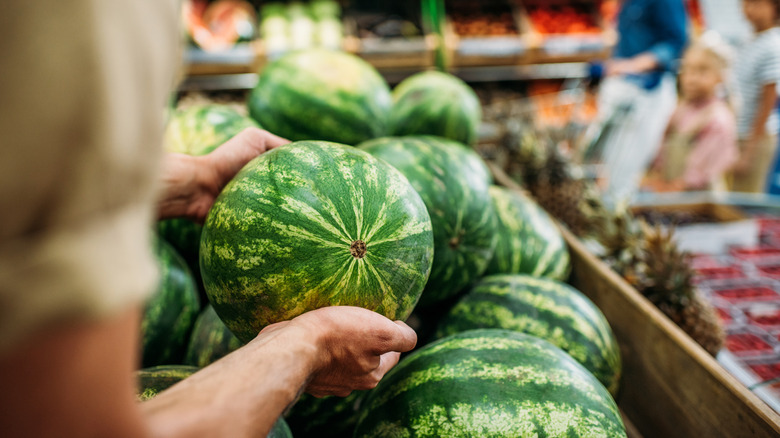How To Choose The Tastiest Watermelon At The Store
Cold, crisp, sweet, refreshing: There's nothing quite like biting into a good piece of fresh watermelon on a hot day. But it has to be a good one to be satisfying. Choose a sub-par watermelon from the supermarket, and you're left with something that's either too mushy, too hard, or just plain flavorless.
Because this hefty, bulbous fruit isn't necessarily cheap, you want to get the most out of the juicy, summery sweetness it can offer. But how do you do that? How do you know which watermelons are winners, and which are the duds to stay away from?
In order to choose a good watermelon, you need to pick a ripe one. And the good news is that there are several things you can pay attention to — from its shape and skin characteristics to what it sounds like — that'll help you determine whether it's reached ideal ripeness. Looking to bite into the watermelon of your dreams? Pick one that's heavy and has a distinctly yellow field spot.
Visual cues for watermelon ripeness
Watermelon is typically in season from late spring to early fall, so the summer months will be your best bet to find a truly good one for that delicious watermelon gazpacho or grilled watermelon salad. If you're on the hunt for one, there are several things about the fruit's appearance that will indicate if it's ripe or not.
You'll notice something called a field spot on the outside of the watermelon, which is a large area where the fruit originally rested on the ground (think of it as a natural bed sore of sorts). Generally, the whiter or lighter the field spot is, the less flavor the watermelon has, so look for large spots that are more yellow-orange colored. And speaking of spots — if you see those dark, dry spots on the watermelon with a web-like texture, that means the watermelon is sure to be a sweet and sugary one.
The fruit's signature stripes are also important: It's best to pick one with stripes that are deeply and distinctly colored, with a more uniform pattern. And a watermelon's shape also makes a difference. If the fruit has lumps, bumps, or is otherwise not uniform, this can indicate that it wasn't pollinated correctly or that it wasn't watered regularly. Some visual cues to stay away from are skin that's too shiny, or a greenish stem — both of which indicate that the fruit hasn't ripened yet.
Audible and tactile cues for watermelon ripeness
Choosing a good watermelon isn't always determined by what you see. Sometimes it's helpful to go a step further and investigate what you can feel — and yes, hear — about the fruit.
First, pick it up. If you grab the biggest one there, which you can barely get your hands around, and it feels surprisingly lighter than you thought it would, put it back and try for another. Sweeter watermelon will be dense inside – so, for example, it's better to pick a smaller one that feels heavier than you think it would rather than a large one that feels light.
And you may have heard about the trick where you knock on the outside of the melon. It's a real thing, and it actually works according to a 2013 study in the Journal of Food Science and Technology. A well-ripened, sweet watermelon will contain a lot of water, so it'll sound different than a watermelon that's under-ripe or overripe. Give it a gentle knock on the outside like you would a door — if it makes a low-pitched thud sound, it's probably overripe; if it makes a high-pitched sound, it's probably not ripe enough. The sweet spot you're listening for: a deep, hollow sound, the tenor of the watermelon world.



